What made these Tracks?
A guide to assist in the interpretation of animal tracks.
The Black Trakka
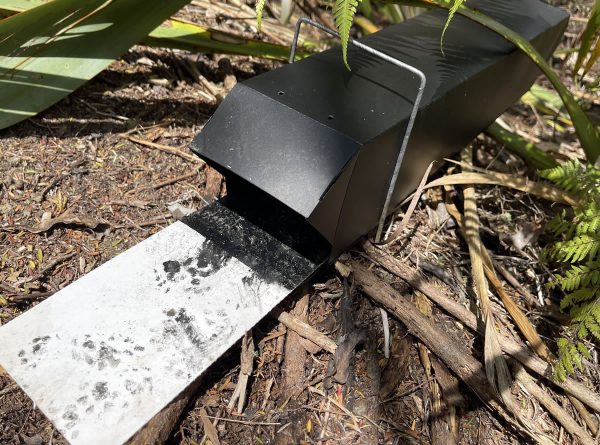 The Black Trakka monitoring system is very widely used within New Zealand. The system was developed with funding assistance from the Stoat Technical Advisory Group of the Department of Conservation. There is a tunnel in which is placed a monitoring card. This card records the footprints of animals as they pass through the tunnel
The Black Trakka monitoring system is very widely used within New Zealand. The system was developed with funding assistance from the Stoat Technical Advisory Group of the Department of Conservation. There is a tunnel in which is placed a monitoring card. This card records the footprints of animals as they pass through the tunnel
I was keen to name the monitoring system in deference to the wonderful Australian Aboriginal trackers whose exploits I often read about as a young boy. Also, the tunnel is black and it tracks.
Why Monitor?
- Monitoring provides insight into the species of animals living in the area.
- Recent developments show individual animals can be identified by their footprints.
- In mammals, a female can be readily identified from a male through the placement of the hind foot.
- Insect tracks allow species to be identified.
- Black Trakkas allow the discovery of species which are otherwise hard to locate.
- Black Trakka data can also be used to determine types of pests which need to be eradicated to produce sanctuaries for the conservation of native wildlife.
- Monitoring provides data on changes in an environment.
Monitoring Card
The card is a water-resistant cardboard comprised of 4 layers. In the middle section of the recording surface, the card is sealed and an especially developed ink is screened on this area where a lure is placed. The viscosity and tack of the ink have been designed so that small insects and very young lizards are not trapped. When animals move from the inked section they carry ink on their feet and leave images of their footprints on the recording section of the card.
- All packs of 50 cards are sealed in an oxygen barrier bag which will give unopened packs a life of a year.
- Once opened keep cards away from the air and in a refrigerator to extend their life.
Placing a Tracking Tunnel
- Most animals prefer to move along fence lines, under trees and around edges of ponds and streams, making all of these places suitable for placing tracking tunnels
- If placing a tunnel under a tree consider covering and camouflaging it with sticks and grass so the tunnel entrance appears as a natural entrance.
- If there are pathways in long grass place a tunnel there.
- For lizards, monitoring cards can be stapled on a horizontal branch without a cover.
Lures
- There generally needs to be a lure placed on the inked section of the card. Place a fingernail-sized amount of an attractant.
- Mustelids will enjoy a section of chicken neck
- For rats, mice, hedgehogs and weta, peanut butter is a great lure.
- Lizards like bananas, pears and honey
- When placing liquid lures, put them in the centre of the tracking card. You can do this by putting them either on a leaf or in a milk bottle cap or simply smear over the ink.
- Experiment with lures as few detailed comparisons have been undertaken.
Footprints
- When an animal leaves an image of its footprint, the natural oils in the ink are absorbed into the card, leaving an image that will neither smudge nor blur.
- The ink is water resistant and will record images of wet feet with the same clarity as dry feet.
- Footprint images can be magnified for detailed analysis. A good magnifying glass can be sufficient or there are electronic microscopes that link to a laptop for under NZ$200.
- With a clear plastic ruler, the widths of feet can be measured and this can indicate individuals and hence densities.
- Animal numbers entering a tunnel can be proportional to the volume of the lure.
- Too many tracks? Reduce the amount of lure?
Targeting Individual Animals
- The width of a foot can be a quick method to establish the presence of a particular animal.
- For example in rats, the four feet are all very similar in width, even though the front feet have 4 toes while the back has 5. The 5th toe is placed on the foot in a similar position to the human thumb on a hand. That is, it is slightly lower on the foot and is positioned on the inside edge.
- Mice have the same foot morphology as rats although their feet are significantly smaller than those of rats.
- So if the footprint is measured it can be determined whether a particular animal is present.
Rats Feet
- Note how the front foot is almost semicircular around the central pad. The toes are placed at quite specific angles to the central pad. There are sometimes two raised bumps which track behind the central pad.
- Measurement of the distance between a. and b. in mm will give a foot size that can be used to compare individuals. In my experience foot widths in rats range from 8mm up to 22mm.
On the back foot, the central pad is split and there is a 5th toe. In this example, the 5th toe [similar to our thumb] is below the central pad and to the right of it. This makes it a left foot. Sometimes raised bumps are tracked just behind the central pad. - All 4 feet on a rat are very similar in width.
Mice Tracks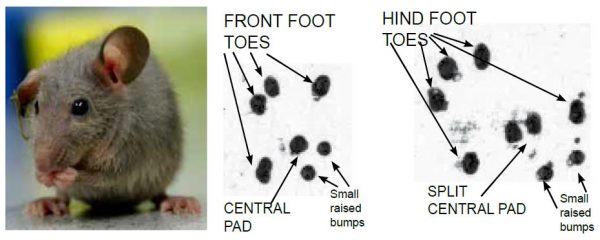
- Mice tracks can appear as a confused mass but on closer examination patterns of feet become quite evident.
- Mice have 4 toes on the front feet and a central pad, and on the back feet, they have 5 toes.
- The pad on the back feet is split and there are 2 raised bumps behind the central pad.
- Three of the toes on the back feet are in a fairly straight line whereas on the front feet the toes create a semi-circular curve. The 5th toe is in a similar position to our thumb in that it comes off the foot from a lower position.
- If mouse tracks are magnified then differences in the size of feet of individuals are measurable.
Mouse Tracks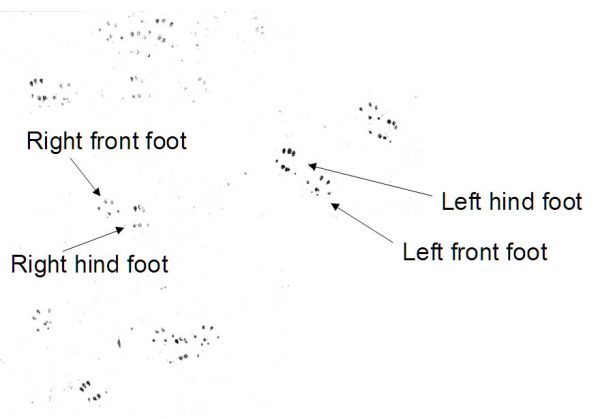
- On the hind foot, 3 of the toes are in almost a straight line.
- The central pad is split and on either side are toes 1 and 5.
- The front foot is semi-circular with 4 toes and a central pad.
- Where the back foot is placed outside of the front foot we have a female.
Mustelid Tracks
- We can now differentiate between stoats, ferrets and weasels, through their footprints.
- In all three species, the hind feet of the females are 50% wider than the front feet.
- If a female mustelid has a front foot 10mm in width the back foot will be 15mm in width.
- These measurements do not vary when the animal is carrying food as the feet do not appear to splay.
- In the males of the three species, the hind feet are only 10% wider than the front feet and the weasel does not track the fifth toe on the hind foot.
- Sometimes stoats will only track four toes on the hind foot but there may be a tiny mark left by the toe claw.
Male Mustelid Tracks
- In the males of the species, the size of the feet is much more similar.
- The back feet are only about 10% wider than the front and to notice this small difference it will probably be necessary to use a ruler.
- In stoats and ferrets the hind feet track 5 toes and a central pad.
- In weasels, the back feet of both males and females only track 4 toes as the fifth toe is too high on the foot to record. Thus we can often identify weasels from stoats.
- Stoats walk up on their toes as though they are ready to spring and this is probably the reason the central pad does not always track.
- Weasels walk with more weight on their heels.
- Even though the weasel is a smaller animal than the stoat, the size of the weasel’s feet is similar to that of stoats.
- The ferret has a central pad on the hind feet which is quite different to that of the stoat and weasel.
Stoat Tracks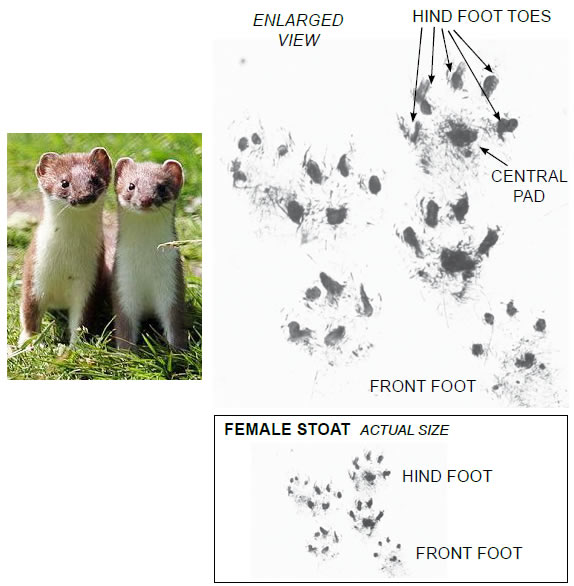
- The front foot of a stoat has 4 toes and doesn’t always track a central pad. The second and third toes are close.
- The mustelid feet are covered in fine hairs, unlike any other mammals.
- The hind foot of the female is 50% wider than the front and doesn’t always track the 5th toe.
- Note the smaller front foot.
Weasel Tracks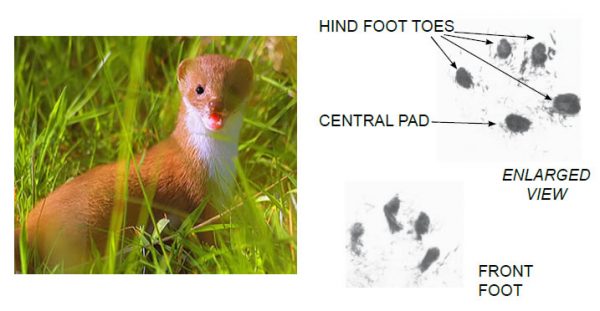
- As with stoats, female weasels have back feet that are 50% wider than their front feet. The weasel has 4 toes on the front foot and 5 on the back foot but on the back foot only 4 of the toes track. The fifth toe is higher on the foot and does not track.
- Male weasels have back feet only 10% wider than their front feet.
- The undersides of the feet are covered in fine hairs.
- To notice the difference enlarge the tracks and measure.
Ferret Tracks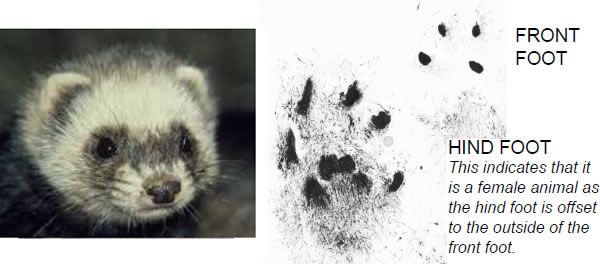
- Ferrets have very fine hairs on the underside of their feet.
- They have 4 toes on their front feet and 5 on their back.
- They do not always track a central pad on their front feet.
- The female has hind feet 50% wider than the front feet
- There is an obvious difference between the front and hind feet, as the hind foot has a central pad with the appearance of an inverted U made up of 4 distinct sections.
- The small front foot is at the top.
Possum Tracks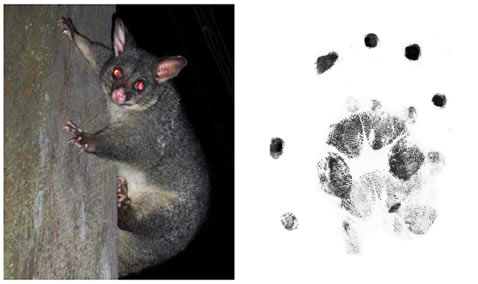
- Possums have circular feet, composed of a central pad divided into 4 main sections.
- The front feet are smaller than the back.
- The claws are 1-1.5cm out from the central pad.
Hedgehogs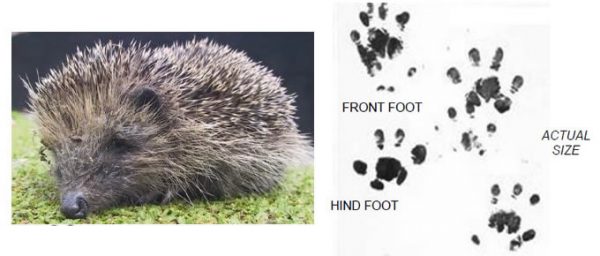
- These tracks are made by a male hedgehog. The hind feet are in line with the front feet.
- There are four toes on the front feet and five on the back feet
- In females, the hind feet would be outside the front as the female’s pelvis is wider than her front shoulders.
Gecko Tracks
- The Black Trakka has helped to determine the presence of species which are otherwise difficult to locate
- Geckos which were previously unreported in the forest areas of Tiritiri were then discovered buried deep in rock crevices after the use of Black Trakkas had indicated their presence.
Gecko on Tiritiri Matangi
- Geckos were rediscovered on Tiritiri after some 20 years of visual searching when tracks were recorded on a Black Trakka card. There were tracks of two adults as the feet widths were different sizes. Along one edge of the card were the tracks of a juvenile. Subsequent investigation located 2 adult and 2 juvenile geckos.
Species-Specific Identification for Lizards
- Thorough research on the foot morphology of New Zealand lizards has been possible through the use of tracking tunnels for species-specific lizard identification and estimating relative population abundance.
- Within geckos, the pattern of the lamella varies noticeably between the species.
- With skinks, the shape of the feet and length of the toes are distinguishing features between species.
- Thanks to Dylan van Winkel and his supervisor Professor Dianne Brunton from Massey University Ecology Group for their work in this field.
- Dylan can be contacted at Bioresearchers Auckland.
Duvauacel’s Gecko (Hoplodactylus duvaucelii)
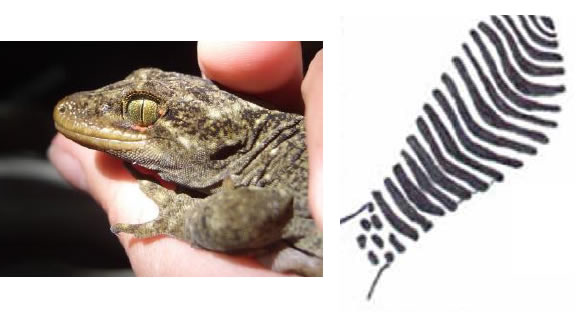
The unique pattern of the lamella on the underside of the foot enables the identification of the different species of gecko.
Green Gecko (Naultinus elegans)
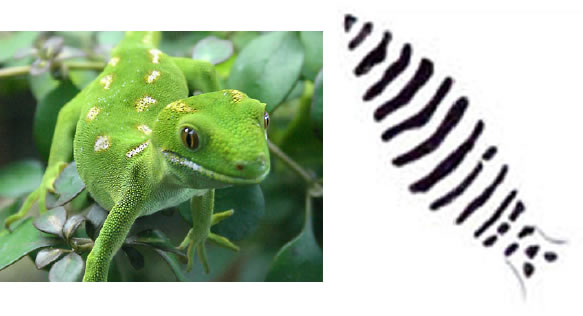
The work of the chemists has produced the ink which will get on the animal’s feet, cause them no harm and still provide fine detail without blurring the detail of the feet. This is the detail on the underside of the toe of the Duvaucel gecko.
Forest Gecko (Hoplodactylus granulatus)
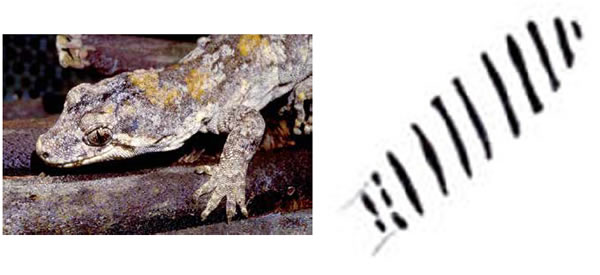
With more and more conservationists and home gardeners using the Black Trakka system discoveries are being made of animals that weren’t known to be in a particular area.
The Jewelled Gecko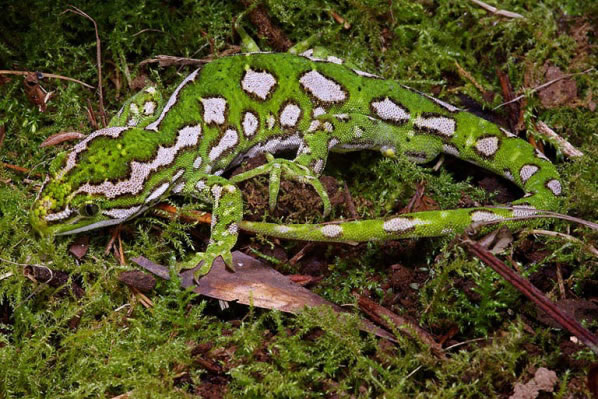
- Recently a person was arrested with a jewelled gecko concealed under his clothing.
- The lizards were all saved and Carey Knox who has been studying these lizards was able to identify the animals through the patterns on their skin and his photographic records he knew the actual trees from where they had been stolen.
- All the stolen lizards were returned safely to their trees.
- Gotcha Traps has donated the monitoring cards for Carey’s research.
Skink Tracks
- Skink tracks are quite often recorded. The tracks are small as can be seen in the left-hand image but can be magnified and at 60x and 200x the lamella on the underside of the feet can be readily observed.
Skink Foot Morphology
- The following slides are the result of Dylan Van Winkel’s outstanding research.
- Dylan followed on from earlier work by a young Sri Lankan scientist Siyam Surbair who was under the direction of Professor Clout of the University of Auckland.
- Following Siyam’s work, the inks were redesigned to prevent young animals from becoming trapped and the ink depth was controlled through an automated process.
- Gotcha Traps supplied cards and we will always consider requests for support from young scientists.
- The detail of the images in the following slides is just wonderful.
Ornate

Whitakeri
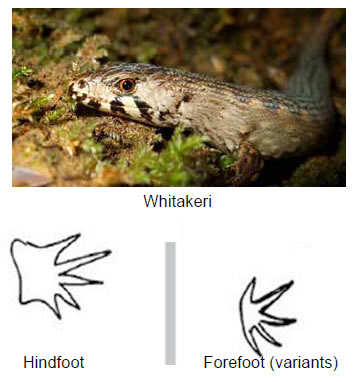
Otagense
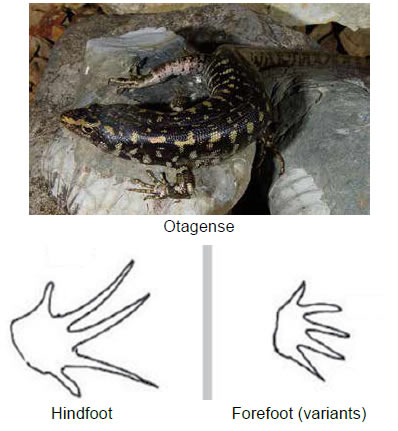
Moco
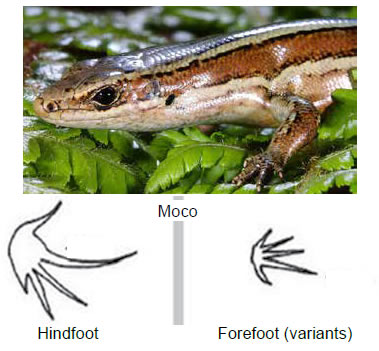
Waimatense
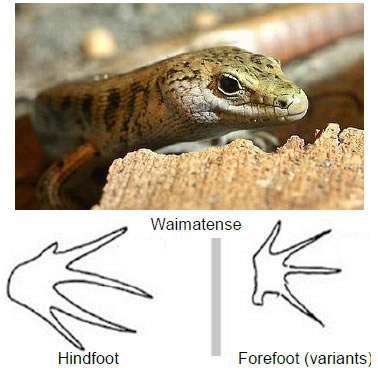
Frogs and Toads

Ant Tracks
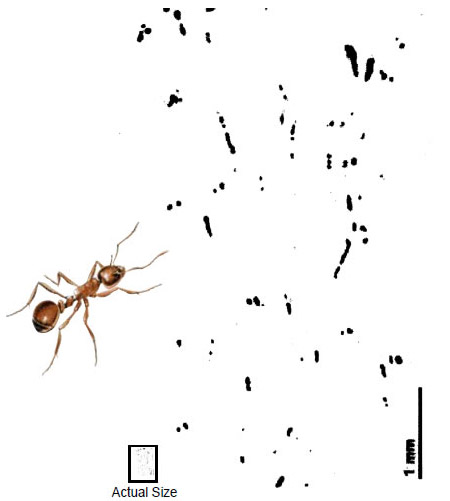
Lizard Images
Dylan van Winkel has a much more extensive resource and he can be approached for advice or for professional surveys.
Insect Tracks
- The ink used for insects has been developed to allow for such small animals to track without them becoming trapped in the ink
- Both the viscosity and the tack of the ink allow for sufficient ink to be retained on the feet and yet still flow down to the underside to make track recording possible.
- The insect tracks in the following slides were recorded by American University students studying at the Ecoquest facility in Kaiaua.
- Thanks to Ria Brejart Director of Ecoquest for her work with the insects.
Ground Weta Tracks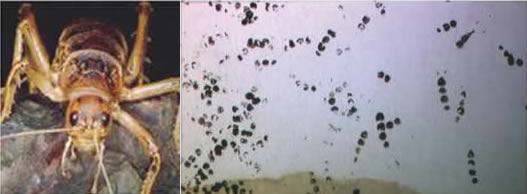
- The Black Trakka system is being used in research programmes on the Giant Weta. The animals are lured by peanut butter. The pad structure varies on different species of weta.
Black Cockroach Tracks
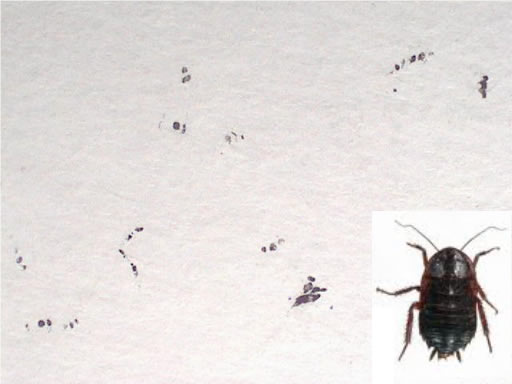
Native Bush Cockroach
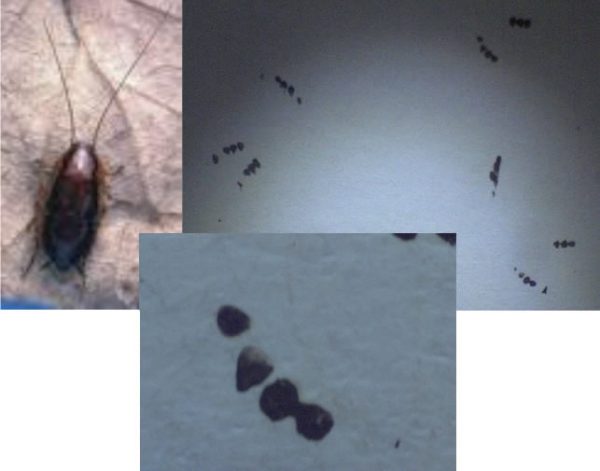
These cockroach tracks can be easily mistaken for weta footprints.
Carabid Beetle
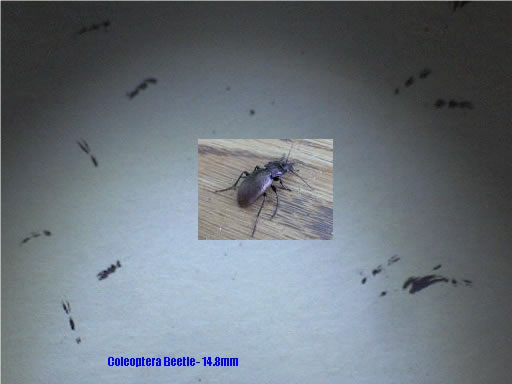
These beetles rapidly build up numbers when rats have been controlled.
European Earwig
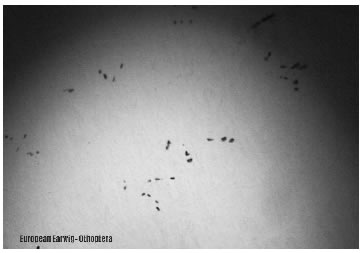
Pill Millipede
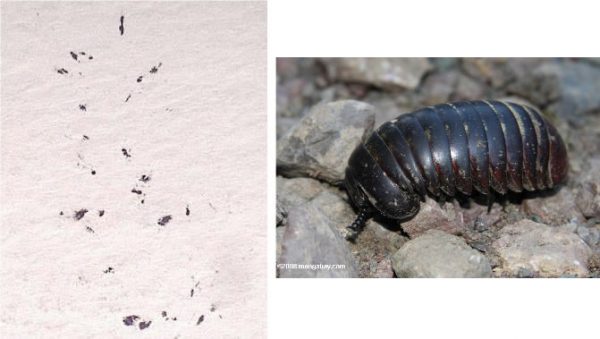
Huhu Beetle
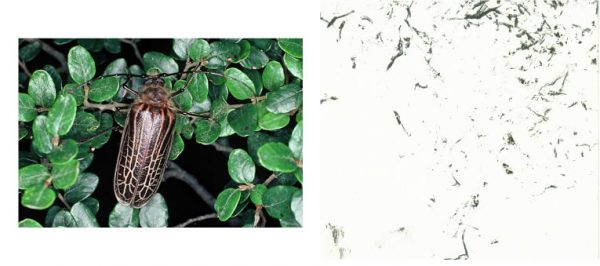
Californian Quail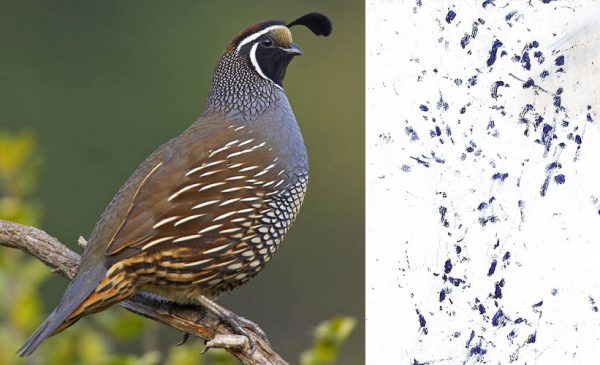
- Professor Brunton noticed quail walking through a tracking tunnel. These are their tracks.
Sugar water is a supplement for the tui who live and nest near our home in an area where monitoring for predators and trapping when necessary, produces a very safe environment. DoC supports this project so long as refined white sugar is used in the liquid feed. Approximately 1 litre of sugar to 4 litres of water.
Thanks to all those professional and amateur environmentalists working so hard to protect the wonderful wildlife to be found in so many different areas of both New Zealand and the rest of the world. Lois and Warren Agnew, Scotts Landing 2010.